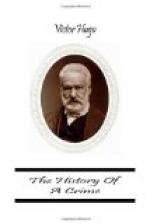The Faubourg presented an extraordinary aspect. The entrance was guarded, but not closed, by two companies of infantry. Two other companies were drawn up in echelons farther on, at short distances, occupying the street, but leaving a free passage. The shops, which were open at the end of the Faubourg, were half closed a hundred yards farther up. The inhabitants, amongst whom I noticed numerous workmen in blouses, were talking together at their doors, and watching the proceedings. I noticed at each step the placards of the coup d’etat untouched.
Beyond the fountain which stands at the corner of the Rue de Charonne the shops were closed. Two lines of soldiers extended on either side of the street of the Faubourg on the kerb of the pavement; the soldiers were stationed at every five paces, with the butts of their muskets resting on their hips, their chests drawn in, their right hand on the trigger, ready to bring to the present, keeping silence in the attitude of expectation. From that point a piece of cannon was stationed at the mouth of each of the side streets which open out of the main road of the Faubourg. Occasionally there was a mortar. To obtain a clear idea of this military arrangement one must imagine two rosaries, extending along the two sides of the Faubourg St. Antoine, of which the soldiers should form the links and the cannon the beads.
Meanwhile my driver became uneasy. He turned round to me and said, “It looks as though we should find barricades out there, sir; shall we turn back?”
“Keep on,” I replied.
He continued to drive straight on.
Suddenly it became impossible to do so. A company of infantry ranged three deep occupied the whole of the street from one pavement to the other. On the right there was a small street. I said to the driver,—
“Take that turning.”
He turned to the right and then to the left. We turned into a labyrinth of streets.
Suddenly I heard a shot.
The driver asked me,—
“Which way are we to go, sir?”
“In the direction in which you hear the shots.”
We were in a narrow street; on my left I saw the inscription above a door, “Grand Lavoir,” and on my right a square with a central building, which looked like a market. The square and the street were deserted. I asked the driver,—
“What street are we in?”
“In the Rue de Cotte.”
“Where is the Cafe Roysin?”
“Straight before us.”
“Drive there.”
He drove on, but slowly. There was another explosion, this time close by us, the end of the street became filled with smoke; at the moment we were passing No. 22, which has a side-door above which I read, “Petit Lavoir.”
Suddenly a voice called out to the driver, “Stop!”
The driver pulled up, and the window of the fiacre being down, a hand was stretched towards mine. I recognized Alexander Rey.




